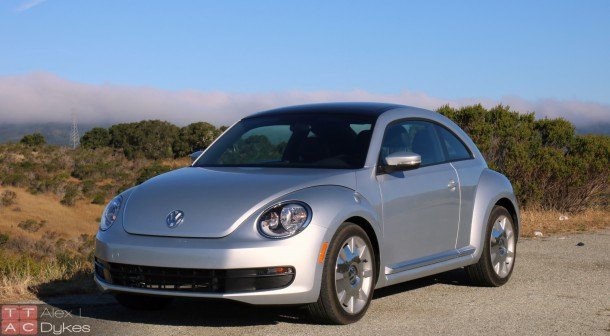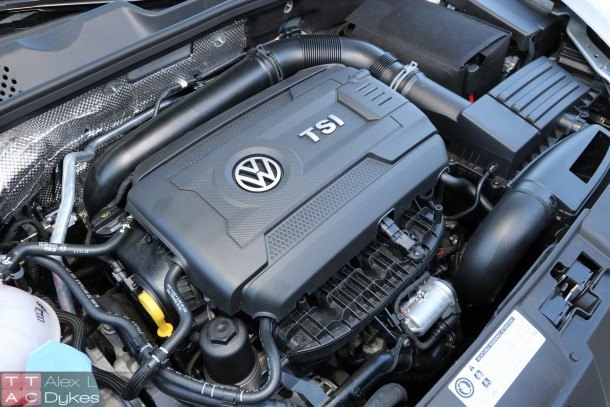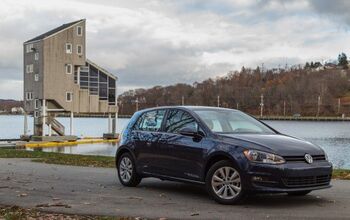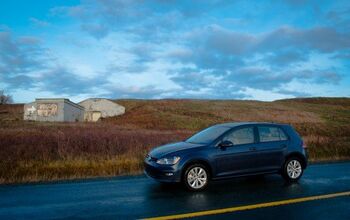2015 Volkswagen Beetle 1.8T Review (With Video)

Once upon a time, Volkswagen’s iconic Beetle sold primarily on its low sticker price, durability reputation and ease of maintenance. VW’s new Bug, however, sells on retro style and a healthy dollop of nostalgia.
The Bug before us today is the second generation “New Beetle” first resurrected in Europe as a 1998 model based on VW’s Golf and A3 platform. It was then redesigned for 2012, sharing its bones with the MK5 Golf and Jetta.
Redesigning retro is always tricky. This explains why the original Bug barely changed over the years and why the other retro-flashbacks like the PT Cruiser and Chevy HHR turned into one-hit wonders. If you don’t change enough, shoppers won’t see a reason to trade Herbie in for a new time capsule. Change it too much and you’re left with a caricature. Either way you slice it, retro comes at a cost.
Exterior
The 2015 model is still instantly recognizable as a Bug, but I think I actually miss the “cutsey” new bug’s overall style. The new front bumper seems especially out-of-place as it exaggerates the front overhang and the crisp creases don’t jibe with the oval lamps and bubbly fenders. The design struck me as a paradox: It is as conservative as we expect from Volkswagen, but slightly discordant with the rest of their product line. For a manufacturer known for elegant, restrained and monolithic styling, the Beetle strikes me as almost cartoonish. Almost. VW offers a fix, however: the Beetle drop-top. By removing the lid, the Beetle loses the “squashed” look and somehow gains rear headroom as well.
Interior
Even on our loaded 1.8T tester ($27,805), VW decided not to borrow the Jetta’s power seats or automatic climate control. Although I found the front seats comfortable for my body shape, the range of motion is limited compared to other compacts. The Bug’s rear seats have become a tad more spacious in this generation, but should still be considered “emergency” seats due to limited leg room. Headroom is tight in the rear, but suitable for folks under 6-feet tall. Compared to the internal competition, you’ll find about 4-inches more rear legroom in the 3-door Golf and nearly 8 inches more in the Jetta sedan. If that surprises you, then you may also be surprised to hear that the Fiat 500 actually gives you more rear legroom than the VW, although cargo room is unquestionably more limited.
Once upon a time, you couldn’t get leather in your Beetle and we’ve come full circle to your choice of cloth or V-Tex leatherette — VW-speak for pleather. Of course, the Beetle is all about retro styling and that’s most apparent in the Classic trim, which is well equipped, bargain priced, and comes upholstered in checkered cloth and brown pleather.
Infotainment
The 5-inch touchscreen is shared with the Jetta and, at this point, is far from a spring chicken. Compared to the latest offerings from the competition, VW’s nav system is slow, less polished, less intuitive and the screen is small. Although the 2015 Golf uses a newer system, the one you really need to wait for is the 2016 “MIB II” system with its larger screen and thoroughly modern software package — but it is expected to feature on other VW models before the Beetle. On the bright side, the optional 9-speaker Fender audio system is totally groovy.
Drivetrain
Also shared with the Jetta is the Beetle’s refreshed 2.0L turbo diesel, good for 160 horsepower and 238 lb-ft of torque. Although it’s a little slower than the 1.8L gasoline turbo, acceleration is aided by a standard six-speed manual and an optional six-speed dual-clutch automated manual (DSG) transmission.
If neither of those drivetrains float your boat, you can still get the Beetle R-Line with the last generation GTI’s 2.0L turbo engine with 210 horsepower and 207 lb-ft of twist. All those ponies are routed to the front wheels via the same six-speed DSG as the TDI model or a slightly tweaked six-speed manual.
Drive
Acceleration in the 1.8T model is excellent for any car in the $20-26K range with 60 happening in 7.5 seconds, notably faster than the old 2.5L five-cylinder model. Although I wish VW had paired this engine to their six-speed manual, the base five speed is well matched to the engine. Shifter feel is excellent, shifter travel is moderate and the clutch pedal had a linear engagement we’ve come to expect from the Germans. The turbo engine’s low-end torque makes hill climbing a breeze and if you get the manual there’s less gear shifting than a comparable naturally-aspirated engine. Steering feel is average for the compact segment with moderate steering effort.
The 2.0L R-Line model I sampled briefly from a local dealer seemed underpowered compared to the modern crop of direct-injection 2.0L turbos on the market, but it is notably faster than the Fiat 500 Abarth. Additionally, the six-speed DSG is a dynamic partner on your favorite winding road. The downside to the R-Line is that it isn’t the same engine you get in the current GTI. The new GTI 2.0L turbo has considerably more torque, a bit more horsepower and it all comes to the boil a little sooner than the old engine. That means the R-Line is not the Beetle-GTI hybrid you may be hoping for. It’s also a little rough around the edges thanks to less sound deadening material in the Beetle.
After a week with the Beetle, which happened to be shortly after my spin in a 2015 GTI and 2015 e-Golf, there’s just no way to sugar coat it: The Jetta and Golf are better options unless you value style over practicality, efficiency and performance. The Beetle is unquestionably more car for your dollar then you’ll find at the Fiat dealer, with more luggage room and a snazzier stereo. The problem is the new Golf is sitting right next to the Beetle on the lot. The Golf is more efficient, roomier, has a bigger trunk, handles better, it’s slightly faster and has a much more premium interior. For about the same price.
Now there is a twist here, and that is the VW Beetle Convertible. At $25,595, the Beetle convertible is better looking than the hard top beetle and it’s one of the best drop-top deals in the USA. VW also offers a 2.0L R-Line convertible and a diesel convertible with a six-speed manual. If you’re contemplating a Beetle and want style, there’s nothing wrong with the hardtop — go right ahead. If you’re on the fence, take my advice and either get the Golf or drop a few more bills and get the Beetle convertible.
Volkswagen provided the vehicle, insurance and one tank of gas for this review.
Specifications as tested
0-30: 2.6 Seconds
0-60: 7.5 Seconds
1/4 Mile: 15.6 Seconds @ 92 MPH
Average Fuel Economy: 28.2 MPG

More by Alex L. Dykes
Latest Car Reviews
Read moreLatest Product Reviews
Read moreRecent Comments
- Theflyersfan With sedans, especially, I wonder how many of those sales are to rental fleets. With the exception of the Civic and Accord, there are still rows of sedans mixed in with the RAV4s at every airport rental lot. I doubt the breakdown in sales is publicly published, so who knows... GM isn't out of the sedan business - Cadillac exists and I can't believe I'm typing this but they are actually decent - and I think they are making a huge mistake, especially if there's an extended oil price hike (cough...Iran...cough) and people want smaller and hybrids. But if one is only tied to the quarterly shareholder reports and not trends and the big picture, bad decisions like this get made.
- Wjtinfwb Not proud of what Stellantis is rolling out?
- Wjtinfwb Absolutely. But not incredibly high-tech, AWD, mega performance sedans with amazing styling and outrageous price tags. GM needs a new Impala and LeSabre. 6 passenger, comfortable, conservative, dead nuts reliable and inexpensive enough for a family guy making 70k a year or less to be able to afford. Ford should bring back the Fusion, modernized, maybe a bit bigger and give us that Hybrid option again. An updated Taurus, harkening back to the Gen 1 and updated version that easily hold 6, offer a huge trunk, elevated handling and ride and modest power that offers great fuel economy. Like the GM have a version that a working mom can afford. The last decade car makers have focused on building cars that American's want, but eliminated what they need. When a Ford Escape of Chevy Blazer can be optioned up to 50k, you've lost the plot.
- Willie If both nations were actually free market economies I would be totally opposed. The US is closer to being one, but China does a lot to prop up the sectors they want to dominate allowing them to sell WAY below cost, functionally dumping their goods in our market to destroy competition. I have seen this in my area recently with shrimp farmed by Chinese comglomerates being sold super cheap to push local producers (who have to live at US prices and obey US laws) out of business.China also has VERY lax safety and environmental laws which reduce costs greatly. It isn't an equal playing field, they don't play fair.
- Willie ~300,000 Camrys and ~200,000 Accords say there is still a market. My wife has a Camry and we have no desire for a payment on something that has worse fuel economy.

























































Comments
Join the conversation
> I never really minded the odd-ball 2.5L five-cylinder VW used to put under the Beetle’s hood, but there is no denying the new 1.8L turbo is a huge improvement. Given the potential for IHI turbo failure in the 1.8 and 2.0 EA888 engines, holding on to the vehicles equipped with the bullet-proof 2.5 5-cylinder is beginning to look like a stroke of freaking genious.
I think a lot of the commenters here, and the author, completely missed the point about the styling. This is actually closer to the shape and proportions of the original Beetle than the New Beetle. The original was full of ovals and a long arching roof. It was the New Beetle that was a caricature of the original. Yes, to me it is butched up but it also looks more nostalgic than the previous one.